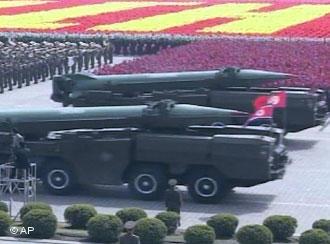Following the Korean War, the treaty ending the war on July 27, 1953 contained a clause that said that neither North Korea or South Korean would introduce new types of weapons to the peninsula. This was generally understood to mean nuclear weapons. In 1956, the U.S. military decided to deploy nuclear missiles in South Korea and announced that it would no longer be bound by that provision of the treaty that ended the war. Despite condemnation by some members of the UN, in 1958, Honest John nuclear missiles and 280mm atomic cannons were sent to South Korea by the US. In 1959, nuclear tipped Matador cruise missiles were also deployed. These missiles could reach China and Russia which upset these communist nations.
North Korea responded by digging massive underground bases and stationing their troops close to the border with South Korea so that any nuclear strike would endanger the South Korean and American troops as well. After the Cuban Missile Crisis between the Soviet Union and the United States in late 1962, the North Koreans no longer trusted the Soviet Union to honor its treaty obligations with North Korea if it was attacked by the South and the U.S. In 1963, North Korea asked the Soviet Union for help in developing nuclear weapons. The Soviet Union refused but did offer to help North Korea create a peaceful nuclear energy program. They completed North Korea’s first reactor in 1967. No other nuclear countries would share weapons technology with North Korea because they feared that North Korea would share such information with China.
Following the collapse of the Soviet Union in 1991, North Korea sought a nonaggression pact with the United States. The United States refused to bilateral negotiations and demanded talks include Red China, Japan, Russia and South Korea. North Korea refused such six way talk. In 1994, an agreement was struck between North Korea and the United States for commercial reactors to generate electricity but they were never built. During the next decade, North Korea alternately cooperated and refused to cooperate with United Nation inspections of their nuclear facilities. They spent some periods of noncooperation producing plutonium. In 2000, a Swiss company signed a contract to build two nuclear reactors in North Korea. In 2004, a U.S. official visited North Korea and confirmed that plutonium reprocessing was being directed to the production of weapons grade plutonium.
In 2006, North Korea announced that it had conducted a nuclear test. Both U.S. and Japanese seismologists detected an earthquake centered in North Korea that seemed to corroborate the North Korean announcement. In 2009, North Korea conducted a second nuclear test of a small bomb at the same location as the 2006 test. Around the same time, North Korea also tested two short range missiles.
In 2011, A.Q. Khan, the man who stole nuclear secrets to help advance the Pakistani nuclear program claimed that he had personally transferred Pakistani nuclear technology to North Korea during the late 1990s. He claimed that the North Koreans had bribed senior Pakistani military officials to gain access to the nuclear secrets. The Pakistani government official denied the charges.
Currently, North Korea has a variety of shot and long range missiles, with the longest range missiles being able to reach six thousand miles. It is estimated that North Korea may have as many as forty atomic bombs which could be fitted to their missiles as warheads.
North Korean Missiles (from Deutsche Welle):

